
Sign in
Don't have an account with us? Sign up using the form below and get some free bonuses!

The quiet child: how can we help them thrive in an extroverted world?
When my daughter was two, I had to schedule at least two hours when we'd go to the grocery store because, being the new talker that she was then, she insisted that we stop and talk to every single person we passed in every single aisle. I'd go in for one tomato and leave with 25 new friends.
She didn't stay that way, though. Over time, some kids, like mine, change to become a more of a quiet child than they were before, while others become more of the extrovert they always were.
Many adults assume, however, that all kids crave BIG attention—the brighter, bolder, and louder, the better. However, some children need space to build trust before they'll delve into conversation or even basic play. And for some of us, giving a quiet child space is a hard concept to grasp—particularly those of us who really want to

connect and who might not be "wired to wait" the same way the child is.
In fact, half the people in the world are introverts. That can leave the other half wondering what to do to
connect with them. So, what can you do when the quiet child you're trying to engage shies away from your attempts? Hint: don't try harder.
I'll admit that for several reasons, I felt odd giving friends who hadn't met my quiet child, who's now solidly introverted, this advice. However, it's proven to be the most helpful tip I've found so far. Bear with me:
Pretend the quiet child is a cat. I mean that in the most respectful of ways. Bear with me.
If you'll forgive the analogy and the generalization, the way to engage puppies—unlike cats—is typically to run, throw balls, pick them up, and roughhouse.
Conversely, a cat typically responds better if you simply find a peaceful place to sit where she can check you out from afar, perhaps come and sniff an outstretched hand, and decide whether to snuggle up or play with a toy you're dangling. If you move too quickly, though, she's likely out of there. She doesn't want you to pursue her.
A quiet child may want to observe her trusted adult's interactions with you before engaging with you directly. If Mom or Dad seems relaxed and happy with you and is following the steps in Supporting the Introverted Child, she can follow her adult's cues and let her guard down when she's ready.
That said, even if you're truly hilarious and other kids burst out in giggles when you surprise them with a "Boo!" they weren't expecting, quiet children often need an entirely different approach.
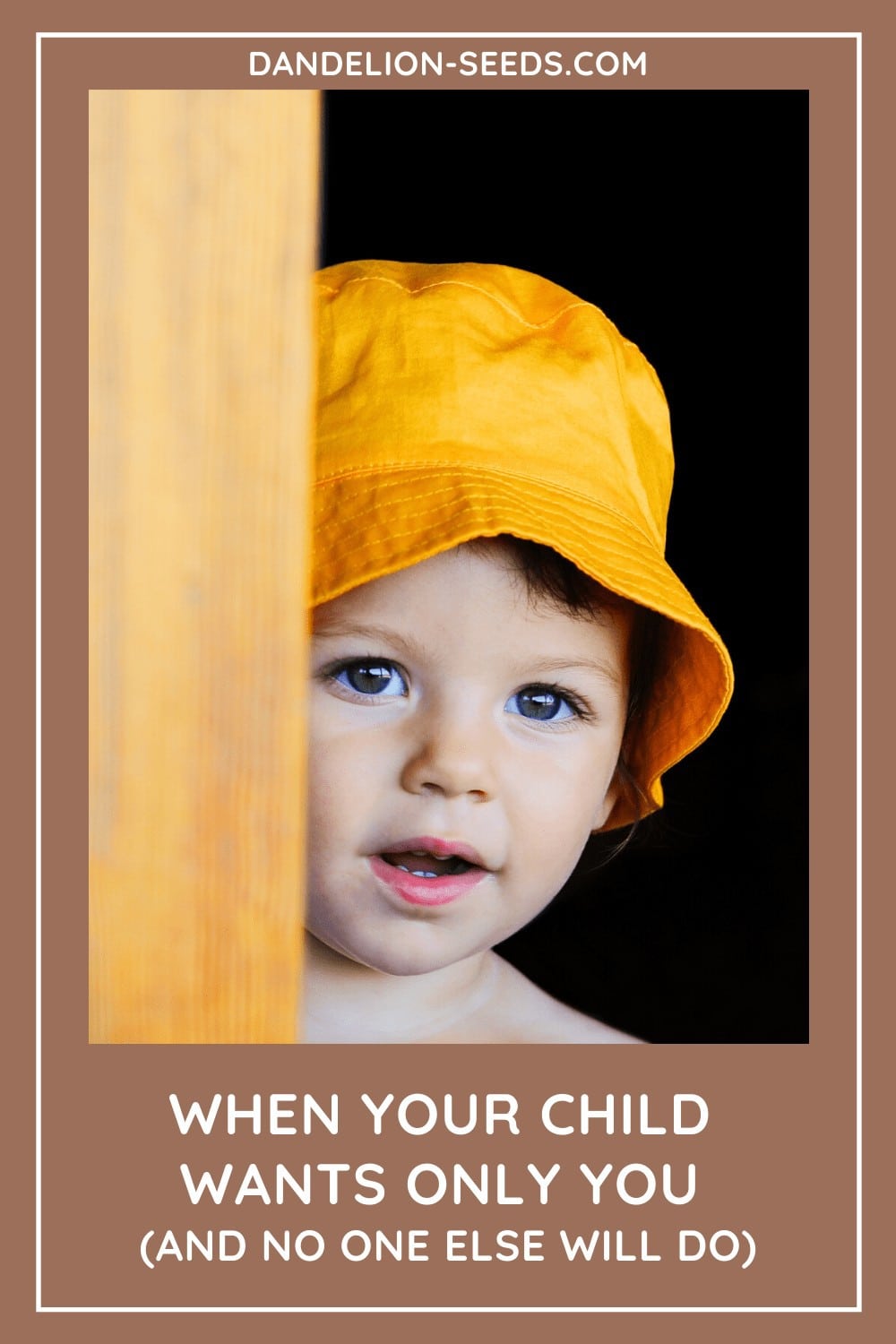
Here's what to try, instead:
In every single case where my friends trusted the "cat suggestion" I gave them privately before meeting my quiet child, it worked. By the time we parted ways, my girl had signaled her comfort by reaching out and holding my friends' hands as we walked together. By the look on my friends' faces, suffice it to say she'd melted their hearts with her subtle connection.

Channel Depeche Mode (am I dating myself?) and enjoy the silence. Keep the loud games, TV, music, and
general distractions off. Some (but not all) introverted children are easily overwhelmed in new situations and have trouble connecting to new people when there's too much chaos to "compete" with their trust-building mechanisms.
If you can find a quiet activity the child enjoys, all the better. Read a children's book alone if you need to. The child can choose whether to engage with you, but it's a good way to establish common ground. Let the child come to you.
Respect the pace, the space, and the child as a whole. Aunt Pat might've expected a hug from you when you were little, even when you hadn't seen her for 1000 years. If you really want a relationship with this child, though, it's less important to recall what was "polite" or expected when you were little, and more important to connect to the child in a way he feels emotionally safe. Consent matters.
This can be tough since it may require you to reevaluate your thinking, but it's important. Let go of who you think he "ought" to be. And by all means, if this child's sensitivity or introversion is cute or otherw
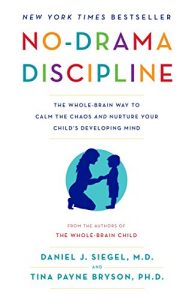
ise funny, don't laugh at him.
Say no more about a quiet child's shyness or quietness to him than you would about a loud child being loud (in other words, say nothing). Although there shouldn't be, there's sometimes a certain stigma to being "shy," and most introverts don't like people labeling them that way. Remember that buildin
g trust is the name of the game. Genuine kindness goes such a long way for all of us.
Most of all, don't give up. It's not personal. Just like we do as adults, kids want authentic connections—particularly kids who aren't naturally the life of the party.
Once you do connect, it can be the most wonderful and genuine reward.
We know that genuine gratitude is scientifically proven to be good for people (source). Further, there are few better ways to foster gratitude and create a sense of meaning than serving others (source). What about acts of kindness for kids, though?
Of course children can do good works for others. Just like with all things, the more they engage in altruistic behavior from a young age, the more natural it can feel for them to continue as they grow older.
Note: this post may contain affiliate links. As an Amazon associate, we earn from qualifying purchases. Your purchases help us support important charities.
You can use an advent-style calendar or multi-compartment storage box and pick a random act of kindness each day. Even a regular old shoebox or a cookie jar can work well. Every day, let your child pull a pre-written note from the container and see what good you get to do together.
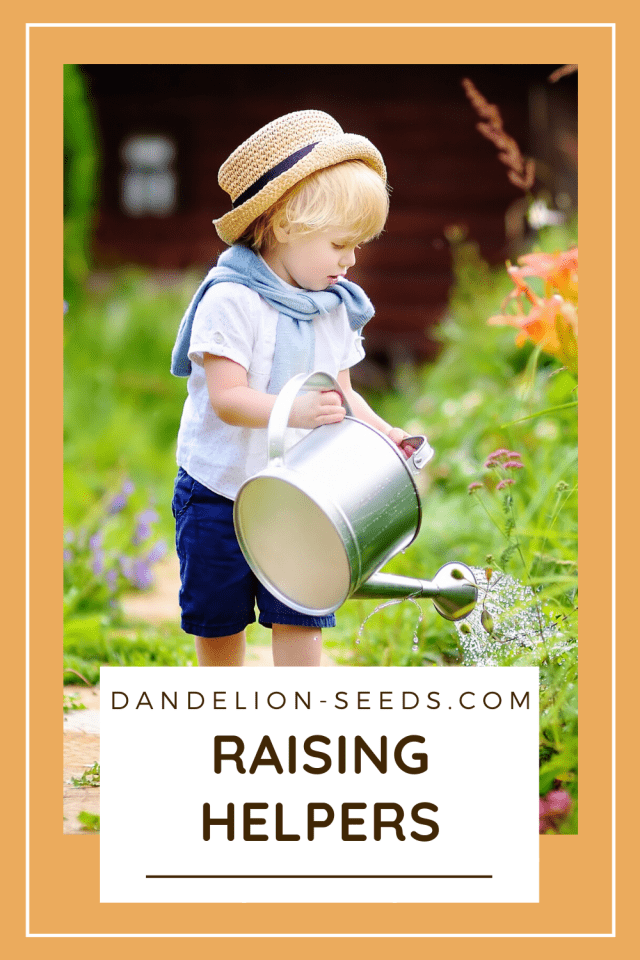

perfectly valid "holidays" these days.

The older your child, the bigger part he or she can play in random acts of kindness for kids. For little kids, especially, you might model raking the leaves more than expect your children to do the heavy lifting. (I bet they'll have lots of fun jumping in piles and bagging them up, though!)
Modeling gratitude without making the work obligatory helps keep the spirit of it all authentic. And of course, opportunities to volunteer increase with your child's age. The focus here is togetherness; acts of kindness for kids are truly ways to have quality time together. Take time to be present with your children.
Acts of kindness for kids have no upper age limit. Let your children see you joyfully engaging alongside them.
Once you've gone through the list and made acts of kindness for kids part of your routine,

challenge your children to continue with their own ideas.
Let them continue to observe you treating others well without expecting anything in return. After all, that's one of the gifts that gratitude fosters, isn't it?
A gratitude garland is an inexpensive and fun craft that helps kids be mindful of others every day. It's also a lovely option for those of us whose crafts aren't, say, Pinterest-worthy. (I'm raising my hand here. Heck, I can barely pack a lunchbox without a map.)
 Most of what you need are common household items:
Most of what you need are common household items:
You and your kids can trace and cut out whatever shape (or shapes) you plan to use. Each day, write one thing for which you're thankful on one of the shapes. Cut a small hole in your shape. Feed your twine or yarn through it, and make sure you cut a long enough length of yarn to last awhile. Use a paperclip to secure your shape to the yarn. Hang the yarn somewhere visible in your home, and each day, recount your blessings together as you add a new one. We find that hanging it over the door frame in the kitchen works well.

It takes practice sometimes. For all of us. But kindness itself can be one of the best gifts of all, and it never needs to be wrapped with a bow.
*
Sarah R. Moore is an internationally published writer and the founder of Dandelion Seeds Positive Parenting. You can follow her on Facebook, Pinterest, and Instagram. She’s currently worldschooling her family. Her glass is half full.
Family bonding is a wonderful thing under normal circumstances. Spending time together with family is simply irreplaceable; it's how we make memories that our children will carry warmly for many years to come. Be it family game nights, Sunday night dinners, or just "Tuesday mornings with Dad," -- things your kids can count on -- they all can be a magical part of the familial bond.
These weeks are hard, though. We're out of our comfort zone. This isn't just quality time; it's quantity time. A whole lot of it. As much as we hate to admit it, we can do only so many things together before we crave a little peace and quiet. It's human nature. And there's no shame in feeling that way -- science says silence helps us regenerate our brain cells.
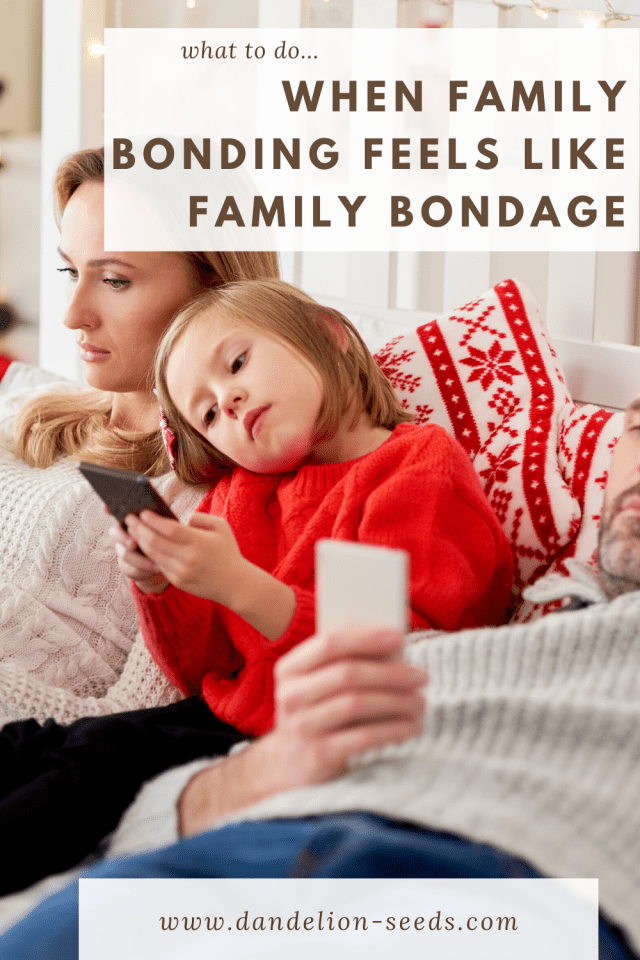
Sometimes, when we spend time with others but wish we were doing something else, we can start to feel

resentful. It’s tempting to mentally check out, disappear into our phones, or get plain ol’ grouchy. When we're in it for the long haul, though, it's helpful to tell ourselves, "I can do this for 10 minutes."
Perhaps it's playing someone else's favorite game (the one that's the bane of our existence); perhaps it's doing something else that we find slightly less than enjoyable. Whatever it is, if you know you're allowing yourself a stretch break / coffee break / mental break in just 10 minutes, you can probably power through it and stay engaged. You might even enjoy it more knowing there’s an end point. Oftentimes, you can check back in with yourself and ask, "Can I do this for 10 more minutes now that I made it through the first 10?" Some of the best parenting is done in 10-minute increments. You've got this.

Family bonding time doesn't mean you "have to spend time with family;" it means you "get to" do it. Remembering those who can't is both humbling and sobering. Perspective is a gift. You get to spend time together. We're doing what we're doing right now because a lot of other people no longer get the opportunity to be together.
As Nathaniel Hawthorne wrote, "Time flies over us, but leaves its shadow behind." Before we know it, these days will merely be shadows, as well.
Family bonding activities can be as simple as looking through an old family photo album together, sitting down

together with some good books, or starting a makeshift band in your living room. It doesn't have to involve anything that would "look good" on social media.
If the activities your five-year-old enjoys don't match those that your 12-year-old would choose, develop a rotation system. (Yes, you get to be a part of it, too.) All family members get to contribute ideas. Putting the ideas into a jar and randomly drawing the "winner" is a great way to keep it fair.
One day, we will look back at this season -- and we will have an emotional memory of how we spent it with our children. Things may not be picture perfect in the world right now (or even close to it), but we have the power to make peace with what we have. We can be available and vulnerable and emotionally present with our families---for our partners, for our children, and for ourselves. This bonding time might just have the potential to be the most healing thing we've ever done together.
*
This article was originally published here.
Sarah R. Moore is an internationally published writer and the founder of Dandelion Seeds Positive Parenting. You can follow her on Facebook, Pinterest, and Instagram. She’s currently worldschooling her family. Her glass is half full.
Worldschooling, or "world schooling" as some spell it, is a form of homeschooling wherein a family will spend time to travel the world and have that life experience be their children's primary form of education. Some families who world school still use curriculum to guide them, while others follow child-led learning. Some families leave public school altogether, while others take a gap year (or year off) for world travel.
That said, sometimes worldschooling happens without leaving the country. I know, for example, a family who rented an RV and toured each of the contiguous 48 states. Another family I know did the same across Europe. Some families pick a new location and stay put indefinitely. There's no one-size-fits-all approach to remote education.
Background: a couple of years ago, my husband, daughter, and I were on a flight home from seeing family on the other side of our home country (the United States). With five hours to spare on the flight, we came up with an extensive list of criteria of what we wanted our life to look like. My husband, in particular, had been feeling "stuck" but hadn't been sure what to do about it.
This conversation sparked something in our hearts, so we wanted to explore it further. Once we got home, my husband -- being the analytical fellow that he is -- put our criteria into a spreadsheet. From there, he started matching up places in the world that matched what we wanted. We'd both lived and worked abroad before so the idea of living internationally wasn't "foreign" to us (no pun intended). Our child was game to try it, too.
As fate would have it, my husband's corporate job was eliminated just a few months later. We weren't inclined to stay in the high-cost city we we'd been calling home, so suddenly, we had the perfect chance to really test out what we wanted out of life.
Life might've just handed us lemons, but we knew just what to do with them!
One month later, with all our worldly belongings in storage and using miles and travel points we'd accumulated over the years, we boarded a plane to Portugal (our first worldschooling stop). We brought only one suitcase each. For the next three months, we hopped from place to place across three European countries, changing location approximately once per week. Our original intent was to find one place and settle for awhile (much less jarring), but this is how it played out without much time for planning beforehand.
Doing this, we learned some really important life lessons.

I've always strived to raise my child to care about the Earth. Until we were essentially forced to live more simply while worldschooling, though, I hadn't realized what an extravagant lifestyle we'd been living at home. To be clear, "extravagant" is a very relative term. Case in point: I own exactly two pairs of yoga pants and three pairs of jeans. Still, compared to most people in the world, we had a lot of stuff. Traveling with just a single suitcase each showed us that yes, we'll be doing laundry more often and wearing the same clothes in a lot of our

photographs. That was about the only "drawback," if you can call it that.
We didn't bring an extra suitcase full of toys because we didn't need them (much less a whole playroom full of them). My child was content with a few of her special toys that we'd brought along on our journey.
Nor did we need a dryer to dry our clothes. Dryers are much less common in Europe (and many other parts of the world). We simply hung our clothes to dry and planned accordingly. As a small act, abandoning the dryer made me feel like I was taking better care of the planet. When we got back to the United States, a drying rack was one of the first things I purchased (afflink). I rarely use my dryer anymore.
Likewise, we didn't need hard copies of books; we read them online (and if you know me, you know I love "holding" a good book).
Furthermore, we had a lot less food waste. We were living in apartments and rental houses (not hotels), so we did all our own cooking. We bought only what we'd need for the week because we didn't want to throw away food that wouldn't travel well.
We changed our consumption in big and small ways. We came back to the U.S. "greener" than we were before, and we're not going back.

Worldschooling was the perfect way to learn how many people want to treat children really, really well. Be it the owner of the ice cream shop in Braga, Portugal, who learned my child's name and favorite ice cream flavor so that she could be sure to make it from scratch for the duration of our stay, to the baker in France who saw my child wasn't eating lunch so he came to our table with freshly baked chocolate cake for her -- people everywhere
cared.
I'm a pretty good judge of character; I could clearly tell they weren't in it for tourism points. My child often wasn't sure what to do with all the pats on the head, all the tender smiles, and all the genuine love she felt from those around us. People went out of their way to make her feel welcome.
Oftentimes, we didn't speak the same language as those around us, but their kindness came through loudly and clearly. THIS is the foundational knowledge I want my child to feel no matter where she is in the world. She saw and felt love and goodness everywhere. That's more important than anything I could possibly show her in a textbook.
Our child was able to hold a 10-line conversation with me in French after being in France for only a couple of weeks. Truth be told, I'd tried halfheartedly, and without much success, to teach her French when we were back at home -- and she hadn't had much interest. Here, though, she said she "just naturally understood" the

language. She felt invited, not by me but by her experience, to engage in her education this way. She learned plenty of other "school" lessons, too, along the way.
Seeing the world through children's eyes is an incredible gift. Every day, we'd venture somewhere new -- a castle, museum, historical site, or just a simple walk in nature surrounded by French countryside. Learning happens quite naturally when everything is novel. It makes our brain's synapses fire in new ways.
It's one thing to read about medieval times in books; it's another to walk through the history of a castle and see it firsthand. The lessons come quite naturally. I truly absorbed material I'd been "taught" many years ago in school; there's nothing like being there. For us as much as for our child, world schooling ignited (and renewed) a passion for learning.
Worldschooling was, as hard as it is to admit it, really one of the first times my child was able to fully connect emotionally with my husband. He'd always been working so many hours in his corporate job that he simply couldn't spend much time with her prior to now. Making up for lost time allowed them to heal, and build, a lot of their familial intimacy. It was equally helpful for my husband and me to reconnect emotionally, too, after years of being too busy. We stopped feeling buried in our phones and in our work. Worldschooling helped us reprioritize our family.
Although we didn't plan to worldschool in the way that it ended up happening, it convinced us that it's a match for our family. We'd be more intentional about it next time (and certainly wouldn't move from place to place every week). This wasn't simply an extended vacation; it was an investment in finding the life we truly desire.
This experience gave us, the parents, a deeper level of compassion and empathy for the human experience around us -- and fueled our desire to fully live more of our life. We're watching those sentiments unfold in our child, as well. We're all the better for it.
Sarah R. Moore is an internationally published writer and the founder of Dandelion Seeds Positive Parenting. You can follow her on Facebook, Pinterest, and Instagram. She’s currently worldschooling her family. Her glass is half full.
As much as I hate to say it, Easter is going to feel really weird for a lot of us this year. We're going to be looking for Easter egg alternatives, for one thing. Why? So that people who need food (and can't get it easily with all the shortages) can have a better chance of eating. Yes, it's important.
Truth be told--and personally--it's always felt wasteful to me to buy a carton of eggs knowing full well that I'm going to decorate them, hide them, and then shortly thereafter, throw them away. I didn't plan to look for Easter egg alternatives for this reason, but in a way, I'm glad to have a reason to start a new tradition. One thing at a time, though.
Fortunately, we have a few good things on our side.

Brainstorming at the dinner table last night, here's what we came up with for Easter egg alternatives. Maybe some of them will work for your home this year, too.

stickers, with colorful tape, paint, or whatever you've got handy!
Easter itself, by its very definition, is a holiday about sacrifice and rebirth. It's about losing one thing so that we can gain another -- a much better "thing" that goes far beyond that which was temporary. When we keep that in mind, it's the perfect metaphor to help us let go of some of our traditions this year -- including Easter eggs -- and help us start something new. There's no time like the present to be putting others first.
I'd love to hear what traditions you're starting this year -- or what you're trying on a temporary basis. Comment below!
Related: The Easter Bunny: Should We Tell Kids the Truth?
Sarah R. Moore is an internationally published writer and the founder of Dandelion Seeds Positive Parenting. You can follow her on Facebook, Pinterest, and Instagram. She’s currently worldschooling her family. Her glass is half full.
Screen addiction snuck into my life like a cat through an open door. Having been a corporate go-getter for nearly 20 years before having my baby, I suddenly realized the culture shock of being home alone with a newborn. I turned to my phone to fill a void of busy-ness and all-day connection---not only to other people, but also to technology.
During the many hours I spent nursing, rocking, and holding my tiny sleeping baby, I stayed connected to others through social media. I was thankful to be home with my child, but the change was jarring nonetheless. Aside from my husband and child, the little people on my screen were often the only people I'd see for days---weeks---on end.
To be fair, I put the phone down every time my child was awake. However, as newborn kids do, she slept a lot. I connected with adults in the only way I feasibly could while she existed in eating/snuggling/new-diaper-requiring perpetuity.
A year came and went, and suddenly we found ourselves moving across the country for my husband's all-consuming new job. There, I knew even fewer people than I had in our prior city, much less people with kids. My newly emerging toddler was wonderful company, but let's face it, she couldn't talk much yet. My smartphone often kept me company when she was sleeping or otherwise occupied.
She was thriving. I, however, was not.
I'd go online only ever so briefly, but I started checking in on social media more and more. I wouldn't watch videos, participate in gaming, or do anything else that was plainly time consuming, but I'd look at social media. I'd go online briefly early in the morning while my husband played with our daughter. I'd check it before making breakfast. Then after breakfast.
Soon, I realized that I'd gone back to corporate go-getter mode. But what exactly was I "getting" from screens this time? No emails from VPs were pouring in. I had no deadlines.
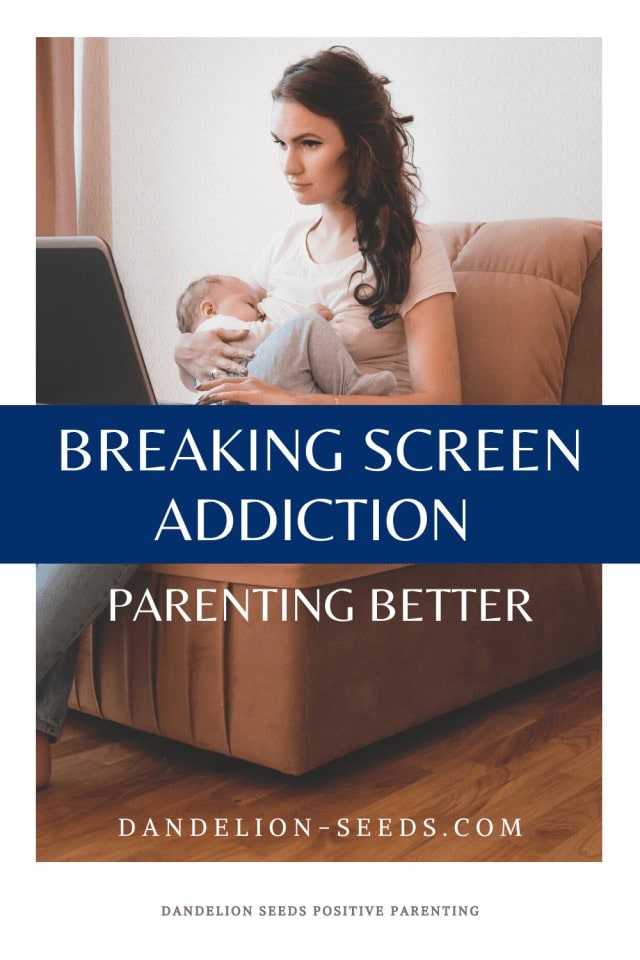
The older my toddler got, the more time she spent awake. However, my screen time didn't always decrease accordingly. I played with her diligently, but sometimes, with loneliness for other adults as my motive, I started to drift away from her mentally. I wasn't "all there" with her.
This really wasn’t okay with me. I hold myself to a higher standard than that.
Still, being a mom is tiring. I'd had more practice with adulthood. While she was safe and cared for, I'd cook...with a screen in hand. While she played, I'd sometimes choose to look at the screen instead of seeing how high she could stack her blocks. In my relative loneliness, my focus shifted to where the other adults were. Online.
At some point, I heard about technology addiction. I researched whether phones were bad for the brain. The science talked a lot about kids. As such, I made a very conscious parenting decision to have virtually no screen time for my toddler (well below what the WHO recommends). As for adults, though, only a study or two caught my attention. One thing I learned was this:
"...While many of the behaviours that are described as screen addition look a lot like other behavioural addictions, there are currently no clinical diagnostic criteria for a disorder called ‘screen addiction’...That said, we may reach a point where problematic screen use does become a recognised behavioural addiction...
The term...has likely come about due to the addiction-like behaviours we see in both adults and kids with respect to their screens. There are three main behaviors that help identify addiction, 1) cravings, 2) tolerance, and 3) withdrawal..." (source)
I was surely "craving" the screen. When I'd try not to look at it for awhile, I started to feel anxiety. That sounded a lot like technology withdrawal to me.
To be clear, recovery didn't happen overnight. I didn't follow any screen addiction program or anything like that. My hours online were far lower than what others would consider addictive behavior, but it felt wrong in my heart. I knew that the old parenting adage was proving true: the days are long but the years are short. I didn't want to miss any more time with my kid, even if we were "just" stacking blocks together. That time mattered. And I wasn't going to get it back.
So, I simply decided to fix it. It was hard. But I killed my screen addiction.

Aware that my screen time ebbed and flowed, I wondered why some days I turned to technology, and other days I opted to spend all my time with real people. It's not like I loved the online community; I love my family. I realized, however, that raising kids is sometimes hard (duh). When my brain just wanted to check out for awhile, I'd visit my screen. I'd read a parenting article (as if that justified it). Particularly when I was tired, I'd want to "veg." What's more mindless than screens?
Knowing my triggers was really helpful so that I could say, "I'm tired today. It's going to be more tempting to be online than when I'm well rested. Today, I choose my child." Self-awareness helped me become more intentional about it.
Was it really that bad? Well, according to the Gottman Institute, stonewalling is being "...unresponsive, making evasive maneuvers such as tuning out, turning away, acting busy, or engaging in obsessive behaviors..." Ouch. Guilty. I was unintentionally doing this; not all the time, but some of the time for sure.
I'd be looking down when the world around me wanted me to look up. Kids don't deserve this. No one does.
I used my phone's built-in technology as well as a couple of other tools that showed me how much time I spent on my phone per day. When I realized how much more productively I could've been spending that time---and by productively, I mean actively loving my family---it was eye opening. And behavior changing.

You know how obnoxious the ding is every time you "like" something on social media? I'd gotten in the habit of turning off my volume because I'd had a baby who was often napping. Once she got bigger, though, I turned the volume back on. As it turns out, it made me rather self-conscious to be holding technology that would "DING!" to everyone within earshot every time I liked a post.
A sure-fire way to stop the DING! is to not be looking at things that make me want to "like" them. Kids look up when the phone makes noises. I didn't want mine looking toward me for that reason.
In my home, phones no longer belong in bedrooms. I moved mine (and its charger) to the kitchen on the other side of the house. It charges overnight. When I wake up, it moves into a kitchen drawer. Out of sight. This simple move makes an incredible difference.
Unless I'm awake before my child, I never look at my phone before I've had a chance to look her in the eye and connect for awhile. Somehow, this sets the stage for how the entire day plays out.
Like many moms, I sometimes visited the "mom cave" (why are we relegated to the bathroom?) and lingered a bit too long. Sure, it's a safe place to go and mentally disconnect for a moment while our kids are safely within earshot, but because of that, it's tempting to stay longer than we need to.
To combat the temptation, I'd refrain from letting my phone tag along. Sometimes, I'd pick up a book if I needed a brief mental escape. However, as much as I love books, they didn't cause the FOMO (fear of missing out) that phones do. I could read a single page and put it back down easily. Then I'd go back to my day.
This change alone made me be more physically and emotionally available to my child. When I could interrupt my screen addiction with a simple change of habit, it worked wonders.

Knowing I didn't want to spend any more time on my smartphone than absolutely necessary, I invested in a watch. Not a fancy one; just one good enough to tell me if I had calls or messages coming in (although nicer ones have their perks).
It's amazing how compelling it is to NOT instantly respond to a text message when it comes in over a watch. After all, the phone's hidden quite inconveniently; screen addiction isn't a problem if I can't reach it. Few messages really require immediate responses.
As a side bonus, my new watch also tracked my steps. Being less physically stagnant made it much easier to achieve my daily exercise goals!
I work online; buy groceries online. However, rather than splitting up my online work throughout the day, I gave myself a set amount of time each day to do it without distraction. Much to my surprise, when I allowed myself focused and productive screen time, I had much less desire to be on phones or computers throughout the rest of the day. I stopped multi-tasking and started feeling much more peaceful; much less scattered. My brain no longer had to feel like it was in several different places at once.
For all other times when I'd otherwise have checked my screens, I kept a notebook and pen handy. Those proved incredibly helpful -- and they also showed me how much wasn't "urgent" to look up.
Further, I scheduled dedicated screen-free parenting time. This offered far more benefits than I even realized it would.
When she was still fairly pre-verbal, I used my watch to mindfully dedicate time to my child. I'd tell myself, "I can play for 10 minutes without interruption." Watching the clock and staying engaged with her, I made sure to meet my goal. Once those 10 minutes were up, I'd do it again. I parented 10 minutes at a time. Pretty soon, 10-minute increments of dedicated time would naturally stack up into long play sessions. I was fully engaged. If I felt tempted to check ahead of time, I'd pause, pray, and start my mental timer over. It worked every single time.
As she got older and we could talk about it, she'd tell me, "Mama, play." That was a positive trigger for me to be conscious of where I was physically and mentally. With some trepidation, I'd ask her, "Was I on my phone too much?" "Yeah." "I apologize, baby. I'm here now. The phone is gone." She didn't have to be "big" for me to own and acknowledge when I'd messed up. We practice modeling forgiveness in our house.
I confessed to my husband that it was really hard to put down my smartphone. At first, he didn't get it. I persisted, though, and he started to see the angst that it was causing me. I asked him to pretend my addiction was of a different nature. If I had a drinking problem, for example, it would've been improper for him to sit down next to me with a glass of wine. I was working so hard to get the phone out of my head, that I didn't want him to remind me of my struggle by holding his phone in front of me.
It was hard for him to embrace this way of thinking, but he saw I was serious about it. Plus, we'd been losing time together because of his work schedule. This was one way to get some of our limited time together back.
Screen addiction is rough on kids. All kids deserve better. It's one of the many reasons I became an advocate for children; for positive parenting and connection. I became happier; more joyful. Although it should've been obvious to me, Facebook and other digital "tools" aren't fulfilling; I need to spend time with real people. Prioritizing family and making friends in my new city healed areas of my life that I hadn't even realized were broken. Now, I see the fruits of my efforts in a wholly connected and positive relationship with my child. This is what parenting should be.
I can tell you that I'd love to have every minute back that I'd wasted---and trade it for more time with the child who's now bigger than she was then. Having recovered from screen addiction, I get it. Overcoming it is hard. But it's doable. And it's 100%, completely, and entirely worth the effort.
Sarah R. Moore is an internationally published writer and the founder of Dandelion Seeds Positive Parenting. You can follow her on Facebook, Pinterest, and Instagram. She’s currently worldschooling her family. Her glass is half full.
Just about every adult in the world would love to take a break from reality this week. And just about every one of those same adults, can’t. We’re somewhere between wanting to know all of the details of what’s going on around us—and wishing we could somehow escape it all.
Here we are at home, though, many of us in uncharted waters with homeschooling, teleworking, or perhaps wondering how we’ll make this work financially. These are tricky times, to be sure.
Of course, I’ve never been through a COVID-19 pandemic before. No one has. However, I have experienced a micro-version of social isolation. For a good long while, it was just me and my small child, 24x7. We were about as isolated as we could be by the world's previous standards and I was lonely as heck. So, this doesn't feel completely foreign to me right now.
I don’t claim it’s even remotely the same as the world’s current situation, but it’s the closest I've got. Here’s what worked for me – ways I’ve truly taken care of myself – when I simply couldn’t take a break.

It’s almost impossible not to breathe deeply while you stretch. The combination of deep breaths and stretching "stimulates receptors in the nervous system that decrease the production of stress hormones." (source) Hold your stretching position for as long as you can. The more you can relax into it, the better. If it's uncomfortable, still wait there as long as you can. You'll feel better for it.
At the moment, screens aren't really allowing us to take a break. We're not coming up refreshed after looking at them. Further, it’s highly unlikely that anything urgent will appear in our newsfeed while we take an hour (or a day) offline. We’d be naïve to understand that screens are linked to anxiety and depression in kids but think they have no effect on us. The screens will be here when you get back. Take a break and see what good things happen.
If you find yourself feeling symptoms of anxiety or withdrawal from your screen time, it might be time to do something about it.
Go in the other room as a family. Eat dinner in the living room. “Camp” in each other’s bedrooms or swap beds for the night. Do whatever you need to, to get out of a funk and feel like you’re creating a safe emotional space. Even taking your laptop into the kitchen rather than the bedroom – or wherever you normally work – can give you a fresher perspective. Look out a different window.
Do you have a happy place? Go there. In fact, I recommend choosing about three of them so you can change your mental scenery as often as you need to. Daydreaming is definitely not a crime. It can prove incredibly beneficial even if you just zone out for awhile amidst the physical or emotional noise around you.
Imagine the details--do you feel the warm sand between your toes? Is there a breeze blowing the trees ever so gently? Are you warm or comfortably cool? What does the air smell like? You know where you feel best. You have the power to go there anytime you'd like. Add enough detail so that it's vivid and relaxing.
Two nights ago, I went to bed frustrated that my house wasn’t clean. I woke up stressed, still looking at the mess around me and wanting the clutter to just.go.away. It didn’t. I got really snippy with my family about it and no one was better for it. I spent most of the day repairing the emotional rupture I'd caused. The next night, I took another approach. I went to bed in a messier-than-usual house and told myself, “My house will still be messy when I wake up in the morning. I am going to sleep knowing this and I make peace with the mess.”
You know what? I was a nicer person the next morning. I legitimately felt better with that attitude. I decided that with everything else going on, some clutter was not a big deal. Paradigm shift.
I often hesitate to share my personal journey with prayer since it’s, well, personal. I can tell you with certainty, however, that when I turn over my worries to the One I believe is always listening to my heart, it gives me peace. Maybe it would give you some peace, too. A good friend of mine who prays recently reminded me that once we turn our cares over to God, we should release them entirely. She has a good point -- if we're handing them over, why would we engage in a tug-of-war to try to pull our worries back? If we're going to trust, trust.
We know where we need boundaries because every time something frustrates us, the message behind it is “This isn’t working for me.” Think of the quiet message of frustration telling you that whatever topic comes up that consistently irritates you is one that you need to address. Perhaps you address it within yourself; perhaps you address it with your children.
If we know, for example, that too much screen time causes behavior issues for our kids, the onus is on us to limit the time they spend online or in front of the TV. To be sure, a lot of kids are going to be spending a LOT more time in front of screens in the coming weeks. If that’s your plan, make peace with it. What you can do, proactively, is decide what times are going to be designated as screen times and which aren’t. My child, for example, does much better with screens if we’re done with them before noon.
If it’s too much indoor time that makes our kids antsy, build in backyard time or a walk on a nature trail away from others.
Playful parenting helps lighten the mood for everyone when people just aren't getting along (or aren't as well as we'd like). It's an absolute win/win situation for you and your kids.
If any other adults live in your home and are able to lovingly care for your children for awhile, even a five-minute breather where you have no responsibility whatsoever can help. Schedule it at a consistent time every day so you know you can count on it. If those “adults” happen to be the characters on an iPad (and your child is old enough / safe alone with it), it’s okay to walk in the other room and fetch a cup of tea. Some of the best advice I've ever heard is "hold your warm cup with both hands." I don't know why, but it's incredibly grounding to do that.
You can also take a break by letting your kids chip in, in ways they usually don't. Let your 5-year-old make lunch for the family. Your only job is to make sure it's actually edible. Cereal is totally okay.
It’s tempting to jump on the bandwagon of calling this chapter of our lives “uncertain times” – because, frankly, they are. I detest the message that phrase suggests, however. It’s as if it’s saying we know nothing; we’re just generally “uncertain.” That’s gaslighting. That’s fear mongering. Those are the words that get us to click on news stories.
Personally, I choose to reframe them as “tricky” times because I can deal with “tricky” or "interesting" or "character building" much better than I can “uncertain.” As adults, we manage tricky situations all the time. Wording matters to my heart. I choose the one that causes the least anxiety.
Take back control of your mental health by not buying into catch phrases, or anything else, that causes undue anxiety. Then use the information about what you DO know to make smart choices about the time you’re spending with your kids. Take a break whenever you need to, even when you're sitting right in the middle of everything else.
Sarah R. Moore is an internationally published writer and the founder of Dandelion Seeds Positive Parenting. You can follow her on Facebook, Pinterest, and Instagram. She’s currently worldschooling her family. Her glass is half full.
Social distancing isn't anything anyone really wants to do, particularly those of us who have kids in the house. We're all used to being active and out places. For right now, though, the centers for disease control are advising that we steer clear of public activities until the novel coronavirus (COVID-19) runs its course (here's what parents should know about it). It's important not only for our own health, but arguably more so, that we do our part to keep those with compromised immune systems safe.
This isn't about us. It's about doing the right thing for those who are counting on us.
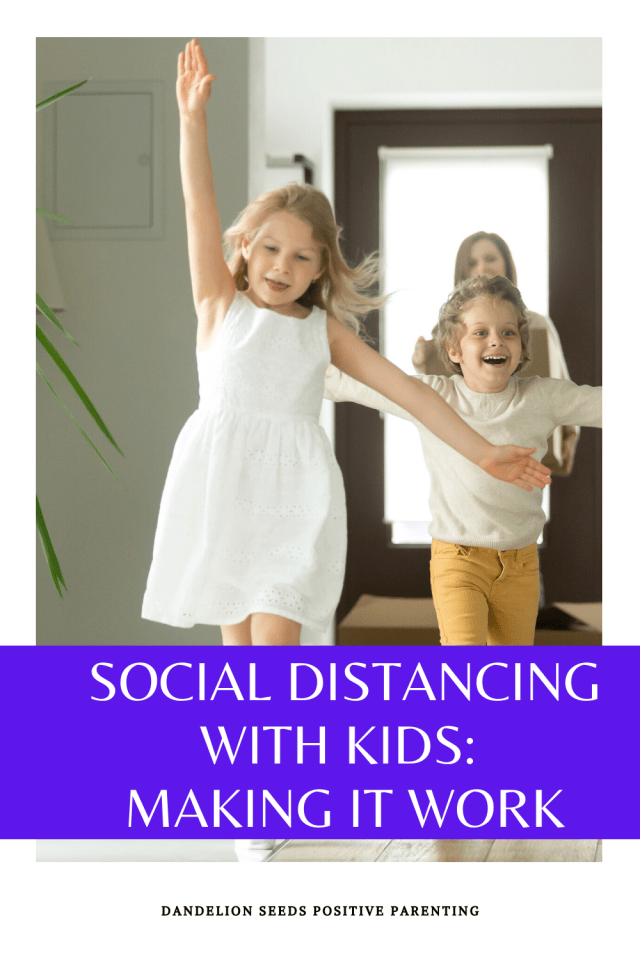
If you're in an area where schools and / or businesses have temporarily closed, don't worry too much about your child's schooling. Think of it as an opportunity to "unschool" for awhile; give kids a break unless they're really struggling with a topic that you want to keep top of mind. If you need to work from home, know that there are many online homeschool options at your disposal. Interest-based learning, where the child chooses what to learn, can be a gift when kids feel cooped up. It helps keep them engaged.
Support local businesses however you can. Many small businesses will suffer significant financial loss from this pandemic. While local delivery options are still available to us (and with hopes that they will remain so), please choose small businesses in lieu of big box corporations that are likely to survive the financial repercussions of social distancing.
If you absolutely must go shopping (for food or essential supplies) in public, consider offering to shop for someone who might be at risk. Do you have a neighbor or friend whose health might be compromised?
This is a stressful time. All sorts of studies show that when we serve others, we’re happier. When you do something to brighten someone else's day, it's a win/win.
Fortunately, there are still plenty of outdoor activities that don't require contact with people outside your family. They also don't require going anywhere where we'd be tempted to touch things (we're steering clear of playgrounds).

Social distancing with kids isn't the easiest thing in the world to do, but it's a small sacrifice to make for control and prevention for those around us. We all want to be part of the solution so we can get back to life as usual.
Sarah R. Moore is an internationally published writer and the founder of Dandelion Seeds Positive Parenting. You can follow her on Facebook, Pinterest, and Instagram. She’s currently worldschooling her family. Her glass is half full.
I get what it feels like to be a lonely mom. Having moved house an average of almost once per year for the first six years of my child's life, I've spent a lot of time trying to make new mom friends. Or any new friends at all, really, regardless of whether or not they're mothers. Some days I'd have settled for a friendly looking giraffe on a cereal box.
Truth be told, besides being lonely, I also spent a good percentage of time back then feeling really discouraged, often alone in a house with a child who was mostly too young to carry on a conversation. Unless you wanted to talk dinosaurs. She had that covered.
My husband was working ridiculous hours at the time. He was often out of the country, so I was married, but largely living a single parent life. (Yes, I realize it's not the same as actually being a single person, and I'm not suggesting it is. I was raised by a single mom and know that life well.)
It didn't help that we had no family within roughly 1000 miles.
Living in a big city, I was surrounded by other humans, but I had no sense of community. My loneliness was fairly profound nearly all the time for those early years.
I knew that many moms feel lonely sometimes, but after having moved and "starting over" so frequently, there was no Ethel to my Lucille Ball; no Betty to my Wilma Flintstone. Where was the magical next door neighbor (with playdate-compatible kids) who I was supposed to find, anyway?

As a stay-at-home mom, was I supposed to walk up to random parents in the grocery store and offer, say, a good looking lemon in exchange for an hour of coffee together? I'd be lying if I said I hadn't considered it.
The more we moved house, not to mention moves to new cities, the more tired I was of feeling "empty," longing for someone to hang out with who was, ideally, more than two feet tall.
An unspoken, but very real, part of motherhood is that it can be one of the loneliest times in our life.
As it turns out, I wasn't alone in my emotional isolation. Being a lonely mom is common. Whether your children are newborns or older, loneliness can affect moms at different times of our lives. Let's explore what's going on here---and then continue with a message of hope and encouragement.
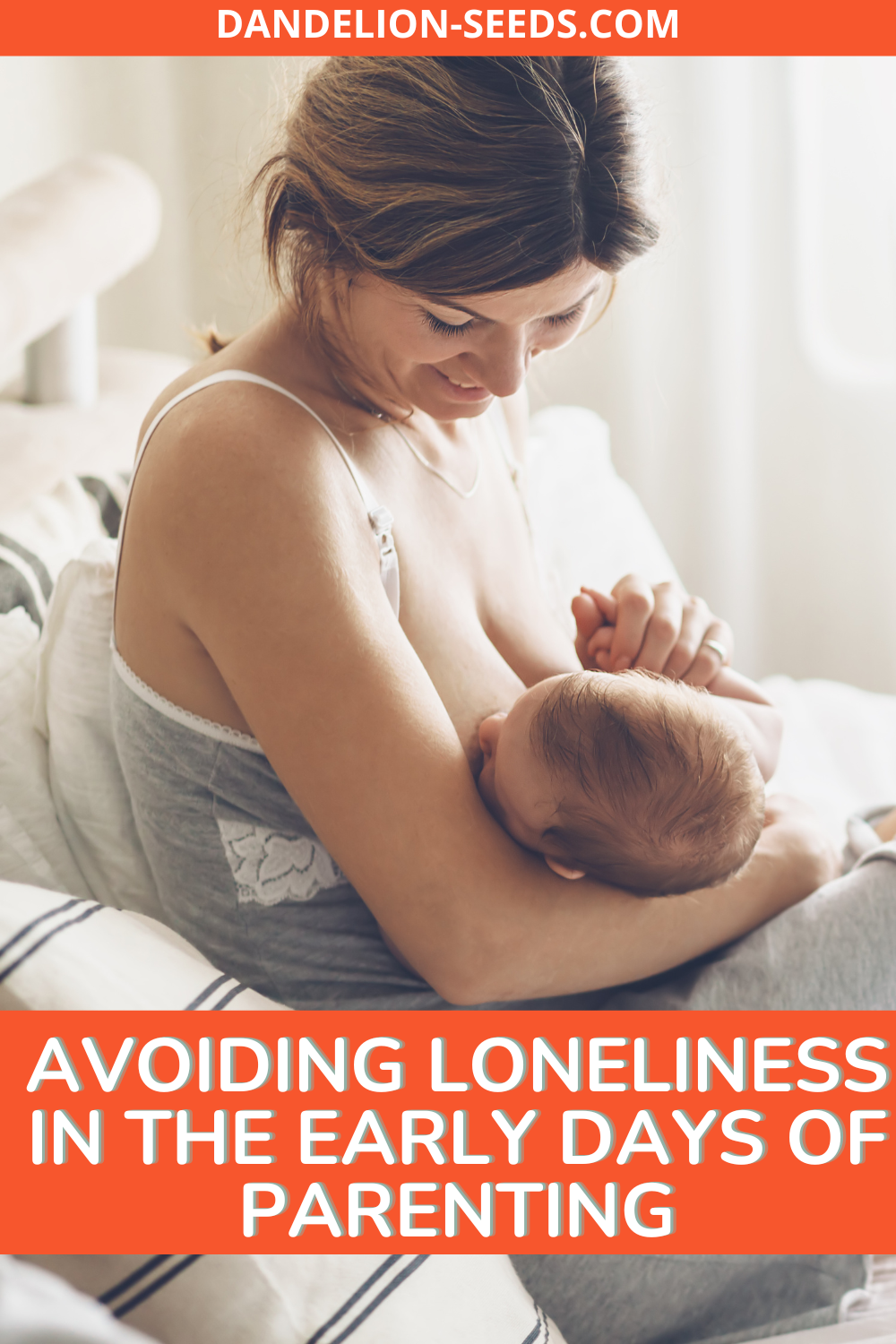
Research demonstrates that motherhood can be lonely:
...28% of new mothers experience loneliness after giving birth to their first child (AXA Healthcare, 2015). Given that becoming a mother is typically characterised as a time of positive emotions, it is perhaps surprising that this figure is in line with the highest estimates for the percentage of adults of childbearing age experiencing more than occasional loneliness (Qualter et al., 2015). (source)
Further, research demonstrates that exhaustion and self-inflicted pressure to be a "good mom" can add to our feelings of being a lonely mom (source). We try so hard to be everything we can be to our baby, child, and husband or partner (if we have one), yet aside from endless games of peek-a-boo, there's often little fun to offset the difficult and ever-present feelings of loneliness.
Moreover, people who are physically or emotionally exhausted can exhibit measurable symptoms that may feel like depression (source).
Stay at home moms or moms without regular support may be particularly vulnerable, although it can affect anyone lacking meaningful social connections. As of 2021, approximately one-third of parents reported feeling lonely (source).
Related: Expert interview with Dr. Sarah Bren about being "good enough" parents, or mini-course: Tired Mom: A Better Way to Manage our Time and Lower Our Stress
New moms, in particular, often struggle with feeling lonely in the brave new world of motherhood. It's all foreign to us, and lacking a so-called "mom tribe" can feel especially isolating while we're figuring out ALL the things.
Especially in new motherhood, mental well-being can suffer significantly.
It goes without saying that there's a tremendous physical toll the early days of parenting on the body (after all, if your child is biologically related to you, you're recovering from having birthed something the size of a watermelon).
On top of this, most new moms report feeling the "baby blues." A notable percentage thereof go on to experience postpartum depression (PPD) or postpartum anxiety (PPA) (17.9% and 13.8%, respectively) (source).
I was a lonely mom, and I was also a mom with PPA.
No one tells us these things about motherhood before we sign up for it; at least, not in terms that seem meaningful at the time. Even if we're told we may feel isolated, it really doesn't hit home until new mothers are spending entire days (and nights) in a continuum of changing, feeding, rocking, and supporting our babies' physical and emotional development.
Although PPD and PPA don't cause the loneliness many moms feel, they certainly wouldn't make new life with baby feel any easier.
Of course, if you're living with PPD or PPA, it's important to address it with a professional and allow yourself to heal. You don't have to (and shouldn't) "tough it out." Help is available, and these days, many treatments are available that may not require medications, if that's a concern.
It can truly be exhausting and overwhelming. Anxiety for the lonely mom is commonplace when it's all so new.

Loneliness in "middle age," once the children are bigger, is common, as well. This is due to a number of factors, not the least among them is that we're often so busy keeping up with our children's busy-all-the-time lives that we simply lose track of our own needs.
We may be surrounded by family and have plenty of people to talk to at home or otherwise, but we may be lacking deeper connections (source). Talking with the parent of a child's friend in passing at a soccer game simply isn't the same as talking with a person who's deeply invested in your well-being.
Without at least one friend on whom we can regularly rely to remind us that we're fun, interesting, and amazing can take a toll on our self-worth. Self-care may go out the window, too, so we're often left feeling pretty empty. As many as 78% of moms say we put off taking care of themselves because we're too busy caring for others (source).
In such a state, who has free time to start connecting with a group of women who magically happen to be in the same life stage?

Even if you're lacking energy, know-how, or confidence, the most important thing to know as a lonely mom is that there are ways to come out of loneliness. You're not wrong for having invested in your family. It's just that you get to matter, too.
Know that everyone feels lonely sometimes. That's normal. Staying a lonely mom, however, isn't healthy, so we can do some productive and specific things to combat loneliness.
I get it. "Self-care" feels cliché at best these days. As stressed and/or lonely moms, we're tired of being told we're wrong for not prioritizing ourselves, and yet, the very idea of exerting more energy is mentally draining.
Fortunately, there are many ways we can take care of ourselves that are within the realm of what we're already doing...just with a few tweaks.

Using social media for the sake of "connectedness" actually caused me to feel like more of a lonely mom than I already was. Although the rational side of me knew it wouldn't work, I felt tempted to trust it to fill my isolation.
To the degree that it sucked me in without any promise of connecting with other adults in real life (much less those who'd spawned children my highly sensitive child would enjoy), I now wish for most of those hours back.
Screen addiction is real. And it's not only debilitating, it also puts us at risk for feeling even more lonely than before.
Scrolling Facebook and Instagram weren't as fulfilling as they were made out to be. I learned that the key to connecting online was to use the tools to see where the (real! 3D!) moms would be. I joined Facebook groups of stay-at-home moms in my area, and based on my specific interests.
I still haven't found the perfect group for "natural health-focused but with occasional ice cream eating, open-minded, gentle parenting moms who are introverts but who really want to hang out, but skip small talk and show up in yoga pants even if we haven't been to a yoga studio in three years."
Working on it.
I digress.
The point was that I found groups that were close enough to what I wanted that I didn't feel like a total goon when I went. There were lots of those.
Then, I mustered up the courage to actually go to the events that my "good enough" FB groups scheduled. Occasionally, another mama and I would click into an instant friendship.
More often than not, though, I experienced the unfortunate reality that is Mommy Cliques, even on social media: troupes of women already committed to one another, not necessarily looking to "adopt" a free-standing and secretly lonely mom into their conversations.
What helped here was to go into these groups not looking for friends, but rather, to seek acquaintances. It's simply good to know people; to know familiar faces.
For me, that was the first step out of loneliness. In that way, social media was helpful. It just wasn't the full antidote to feeling lonely.
Social media isn't the only place a mother can feel a sense of connection with other moms. If you feel better knowing others are lonely sometimes, too, the Loneliness Project may be worth a look.
Here, many people have shared their stories of loneliness, so you know you're not alone.
Being a fairly unassuming person raising an introverted child who was also highly sensitive, gently elbowing my way into group conversations wasn't particularly productive. So, I found a better way.
I learned to look for the other parents who looked like they might feel lonely.
Search for the moms who are standing alone at the playground.
Avoid the ones who are engrossed on their phones; seek out those who are warmly engaging with their children. Walk up and say hi. If "hi" isn't your thing (it takes guts!), smile.
Pay them a compliment. Say something nice about their child.
Sometimes the lonely mom is an introvert, too, and it's not easy to make friends with strangers!
The following tips should help no matter your personality. They're all quick exchanges that don't involve much emotional investment.
The worst that can happen is that someone is impolite in response. That's happened to me only a couple of times. Mostly, people are kind. I've never regretted trying.

In my experience, you do need to push yourself out of your comfort zone.
Unfortunately, it's unlikely that anyone will seek you out if you're not actively making yourself available to meet them. These icebreakers worked best for me.
Notice that I'm being direct about my intentions:
If you're wondering if these are essentially pick-up lines, the answer is yes. They're shameless but effective conversation starters to make friends.
When you feel like you need to connect with other people to be happy, you're right. No one should spend any considerable amount of time feeling like they don't "belong."
For me, however, I realized that I was making my loneliness about my own desire for happiness, rather than about what I could be doing to bring others joy.
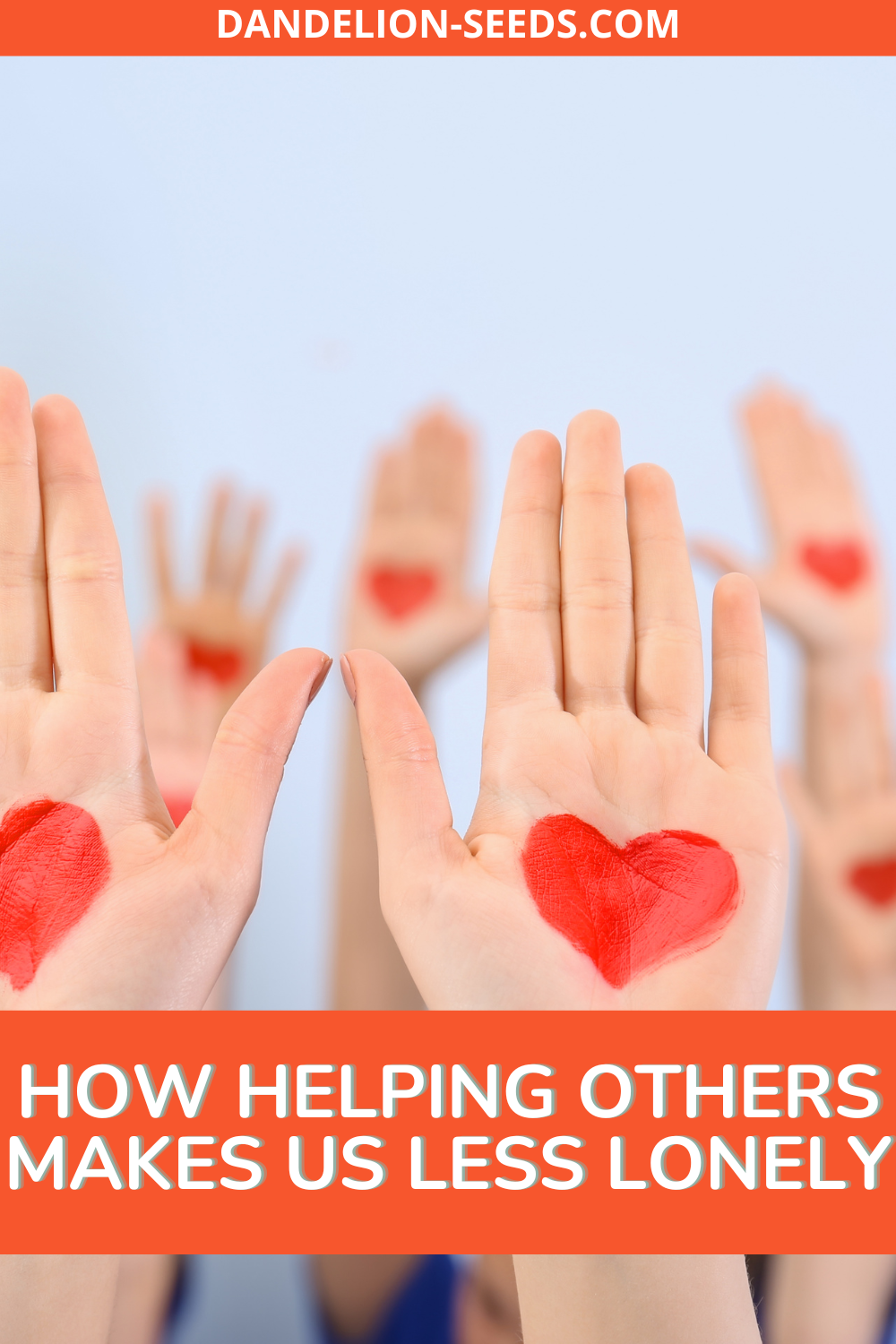
No one talks about this part of being a lonely mom, but I'll risk it: my own feelings of "Hey, people should be embracing me" were, well, all about me.
Here's the funny part, though.
All sorts of studies show that when we serve others, we're happier. That's a form of true connection. It helps give meaning and purpose to otherwise solitary days---and helps shift our focus outward.
Involving kids in serving others is beneficial, too.
Related post: 25 Acts of Kindness for Kids
It helps teach them their impact on society and broadens their horizons.
Your efforts don't need to be big. Start by smiling at others as you walk down the street. It might be exactly the gift someone needs that day.
And you just might happen to meet someone you like.
As a lonely mom, I realized two things: "I really want to connect with others," and "My mental health suffers when I don't."
I also realized that connecting didn't always need to come in the form of new friends.
Indeed, it's great to connect with people in person. What still works surprisingly well is to talk on the phone with my best friend from junior high or a friend I knew from graduate school.
We don't have kids who are the same age. We can't have playdates. But they know me. They love me. And no matter how far we live from one another, every time we speak, we pick up right where we left off.
That, more than anything else, is often what my heart needs.
If we keep "putting ourselves out there," one of the new mamas we meet might someday turn into exactly that kind of friend, too.
In an ideal world, mom friends just "pop up" when we need them. However, reality is that we have to put in some effort into connecting in our community if we expect to climb out of the loneliness hole.
It's possible, though, one step at a time. And most moms in the world really do "get it," and many who've been there sincerely want to help.
Meeting other women is helpful, but connecting with just one single mom friend can reduce feelings of social isolation.
From there, you'll connect with more like-minded people---whether you're still living in your hometown or you've moved a million miles away.
Sometime before Valentine’s Day every year, people start thinking about how to show their loved ones how they feel. Of course, we try to do it all year ‘round (and some boycott the holiday entirely for that reason)—but the world around us seems to primarily focus on February 14.
I’d like to propose a happy medium: how about if we use Valentine’s Day as the impetus for sharing our affection as an all-year habit? Expert James Clear say that it takes 66 days on average to form a new habit, so let's get you started with 33 days of ideas to start the connection. Once you have the first half (the 33) under your belt, you can see what worked well for your family and continue it from there. No worries, though--if the thought of doing these things every day for 33 days in a row overwhelms you, spread them out. What matters in creating a habit is that you time your events consistently. Try "every Friday afternoon," for example.
The spirit of Valentine's isn't just about the holiday, of course; it's about everyday relationships with our families. It's about raising kids in positive, loving homes where they feel cherished and special no matter the time of year.
St. Valentine is you, dear parent or care giver. The real St. Valentine hasn't been around since 269 AD, so it's pretty much on us to go back in time--and bring this day of love forward to present day for our children.
Of course, some think of gifts for valentines. And it's fine to give your child an impromptu gift, no matter how small (afflinks). Gifts, after all, are one of the five love languages, and some children do view gifts as signs of affection from the people they love.

This list doesn't focus on gifts for the holiday, however--it's all about connecting with the people we love.
That's what they need every day of the year. Connection isn't bought; it's made. And it's certainly not made only on February 14; it's always a work in progress. That's one of the many wonderful things about love: it's among the very few gifts of which we can never have too much. Every day can feel like a holiday when kids' emotional cups are full of connection with the people who matter most to them---their forever Valentine. You.